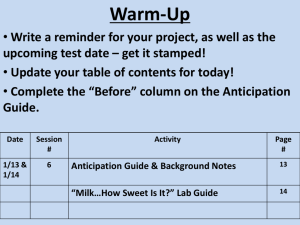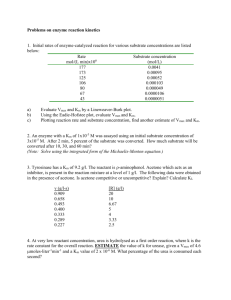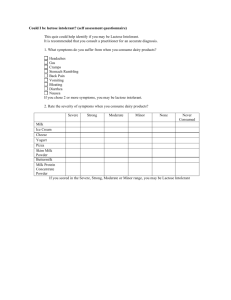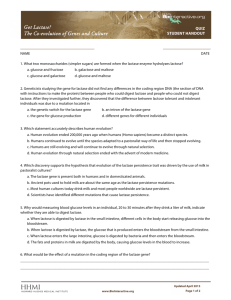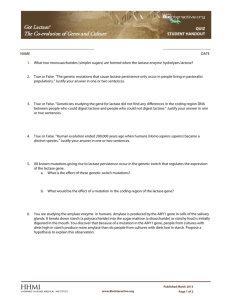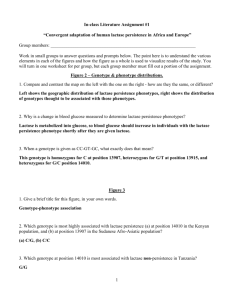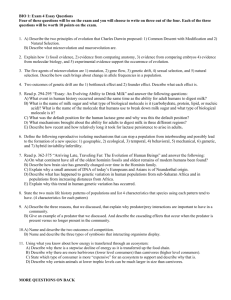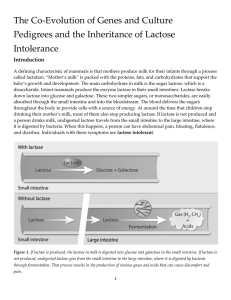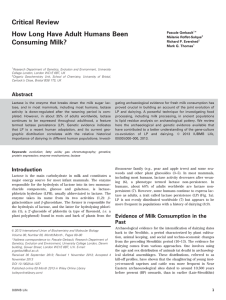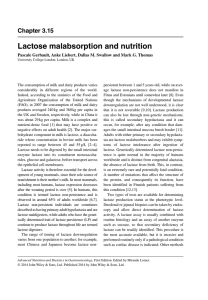Co-Evolution of Genes and Culture
advertisement
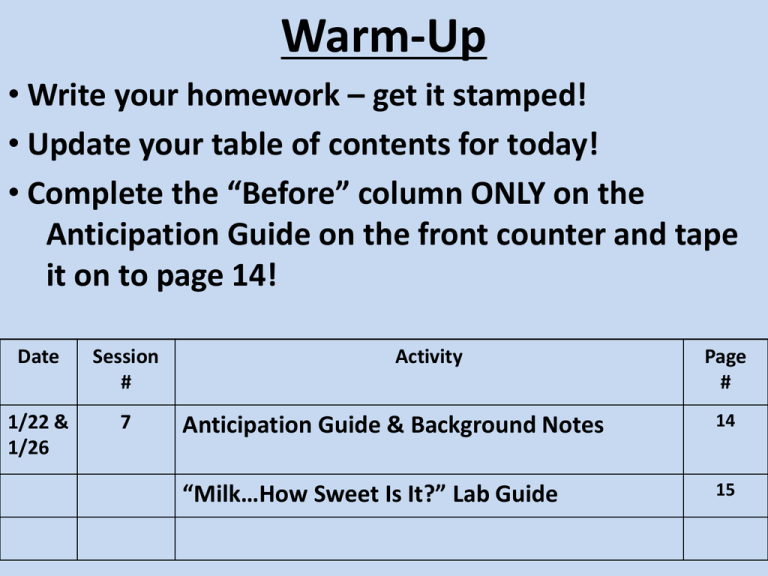
Warm-Up • Write your homework – get it stamped! • Update your table of contents for today! • Complete the “Before” column ONLY on the Anticipation Guide on the front counter and tape it on to page 14! Date Session # 1/22 & 1/26 7 Activity Page # Anticipation Guide & Background Notes 14 “Milk…How Sweet Is It?” Lab Guide 15 Warm-Up • What were your answers on the Anticipation Guide? • What do you think coevolution is? • Starting with the next slide, whatever is in black are the notes you should be writing! Coevolution Coevolution – when 2 (or more) organisms or things affect each other’s evolution/evolve together dependent on each other Lactose Vs. Lactase Notes • Lactose = a sugar found only in milk • Lactase = an enzyme found in the lining of the small intestine that breaks lactose down into glucose, which can be digested by the body Just FYI… Enzyme = a substance produced by a living organism that acts as a catalyst to bring about a specific biochemical reaction Lactose Vs. Lactase • What does lactose intolerance mean? • So what do you think lactase persistence means? • These are genetic characteristics…so, do you think that it is more likely for people to be lactose intolerant or lactase persistent? The Facts About Lactose Intolerance: Remember, Milk has Sugar, Fats & Proteins! • Lactose intolerant people cannot digest the sugar (lactose) in milk because they do not create enough of the lactase enzyme. • Because the milk “races through” the digestive system very little of the other nutrients (fats & proteins) can be absorbed Milk – How Sweet Is It? Lab • Your group will have a sample of the “intestinal fluid” of a patient. You will test the fluid to determine if your patient has the gene for lactase persistence and is able to digest milk. • Follow the lab directions and share your data with the class by adding your data to the table on the board. • Answer the lab questions on your sheet. Milk – How Sweet Is It? Lab Roles • Group Leader – reads all directions and keeps group on task; reinforces the jobs of others • Supply Manager/Clean Up – manages supplies & cleans up after both parts of the lab are complete • Math & Map Master – does calculations & is in charge of recording math & map information (someone with a phone & an agenda to use the map in the front of it) • Discussion Leader – Leads the discussion of the questions to share information with the group and the class if required Milk – How Sweet Is It? Lab Results Samples Patient #1 (Japan) Patient #2 (Kenya) Patient #3 (China) Patient #4 (Italy) Patient #5 (Papua New Guinea) Patient #6 (Finland) Patient #7 (Saudi Arabia) Patient #8 (Uganda) 2 minutes Glucose levels (mg/dL) Lactose Intolerant or Lactase Persistent? Global Distribution of the Lactase Persistence Genotype You will analyze the distribution of lactase persistence (ability to digest milk) across a large area of the world. 1. Calculate the frequency of lactase persistence for the 3-4 regions on your strip of paper. 2. For each region, you must put a sticker on the board. If the percentage is less than 40%, place a pink sticker, if the percentage is equal to or greater than 40%, place a green sticker. = lactose intolerance = lactase persistence 3. When you have the percentages calculated, send your Math & Map Master to place the stickers on the correct country on the map on the board. 1. Create a key for the map on your answer sheet. - Green for lactase persistence (ability to digest milk ≥ 40%) - Red for lactose intolerance (ability to digest milk < 40%) 2. Using dots or shading, duplicate the class data on the map on your note guide. Global Distribution of the Lactase Persistence Genotype Answer the activity questions below the map on your note sheet Got Lactase? The Co-Evolution of Genes & Culture Got Lactase: The Co-Evolution of Genes and Culture http://www.hhmi.org/biointeractive/making-fittest-got-lactase-co-evolution-genes-and-culture https://www.youtube.com/watch?v=umiLaW5AmKg&noredirect=1 • During the video, answer the video questions 1-4 • After the video, go back to the Anticipation Guide from your WarmUp and fill out the “After” column, and then answer question 5. HOMEWORK: Answer the reflection questions on the back of the note guide by next class!
